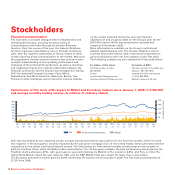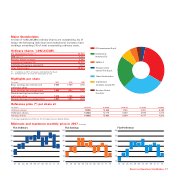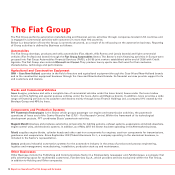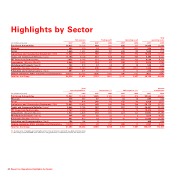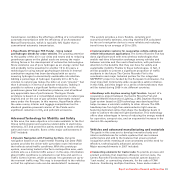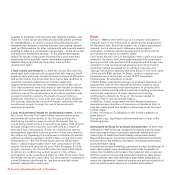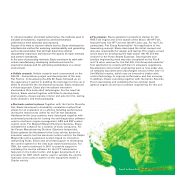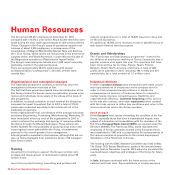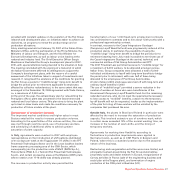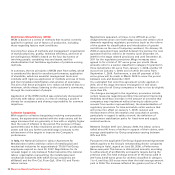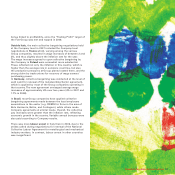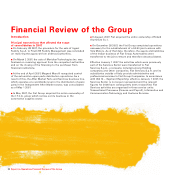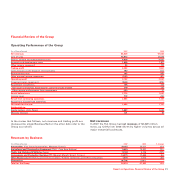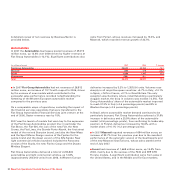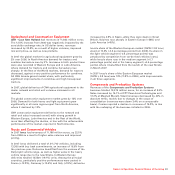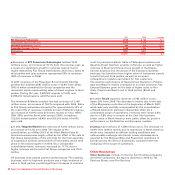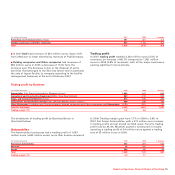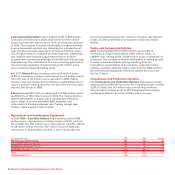Chrysler 2007 Annual Report Download - page 27
Download and view the complete annual report
Please find page 27 of the 2007 Chrysler annual report below. You can navigate through the pages in the report by either clicking on the pages listed below, or by using the keyword search tool below to find specific information within the annual report.The Group had 185,227 employees at December 31, 2007,
compared with 172,012 a year earlier. About 32,300 new hires were
made during the year, while approximately 21,400 persons left the
Group. Changes in the Group’s scope of operations caused a net
increase of about 2,300 employees, in consequence of the
consolidation of Magneti Marelli After Market Parts and Services,
the I.T.C.A. Group, which carries out its business in the automotive
supplies sector, and Teksid Aluminum, in part offset by the sale of
the Magnesium operations of Teksid and of Ingest Facility.
The Group’s new employees include over 1,649 recent university
graduates, mainly in the engineering area.
There are approximately 28,000 employees with special
professional skills (“professionals”), and 43% of them work
outside Italy.
Organizational and managerial changes
The leadership programme continues to be the key driver for
management of human resources at Fiat.
The fact that three years have passed since its introduction at the
Fiat Group renders the human resources evaluation process more
mature and individuals more aware of the values at the basis of
this programme.
In addition, its steady extension to most levels of the Group has
increased its impact throughout Fiat. In 2007, a total of 27,000
people were evaluated according to the criteria set out in the
leadership programme.
At the organizational level, coordinators of the principal corporate
processes (Engineering, Purchasing, Manufacturing, Marketing, IT)
were introduced at the top level of the organization in 2007 in
order to enhance the exchange and synergy of resources within
the Group through its different Businesses. These actions will
further facilitate the real possibility of pursuing cross-sector and
cross-regional career paths within the Group, a fundamental
premise for the overall growth of our management.
Internal growth is essential to the business, although Fiat did not
give up hiring managers from outside the Group (158 managers
were hired in 2007).
Training
Investment in training to support the Group’s activity and
professional development of individuals totalled about 99
million euros.
Isvor Fiat provided training, consulting and professional
support programmes for a total of 18,360 classroom days and
on-the-job assistance.
An additional 18,780 users received a total of 223,550 hours of
web-based distance learning support.
Grants and Scholarships
The “Fiat Grants and Scholarships programme” reserved for
the children of employees working at Group Companies was a
popular success once again this year. The countries that have
been involved thus far are Italy, France, Spain, Poland,
Belgium, Brazil, North America, and China. A total of 685
grants were awarded in 2007, including 194 in Italy and 491
outside Italy, for a total amount of 1.2 million euros.
Industrial relations
In 2007 a constant dialogue was maintained with trade unions
and representatives of employees at the company level in
order to find consensus-based solutions to handle the
consequences on workers of measures taken to respond to
market needs, improve competitiveness, flexibility, and
organisational efficiency. Collective bargaining at the various
levels was also intense, and major agreements were reached
with the trade unions to define pay conditions and rules in the
various countries where the Group operates.
Social dialogue
At the European level, issues concerning the condition of the Fiat
Group, especially those that have a transnational impact, were
subject of information and consultation with the members of the
Fiat Group European Works Council (EWC), as required under EU
Directive 45/94/EC. The Fiat Group EWC, which represents the
employees of Group companies located in the European Union,
was established in 1997 and is comprised by 30 representatives of
the various countries in proportion to the current employment
distribution of the Fiat Group in Europe.
The meeting with the EWC Selected Committee was held in May.
The Group CEO, Sergio Marchionne, spoke at the annual plenary
meeting held on November 5 and 6, 2007, where he presented the
results achieved, objectives and strategies of the Group for future
years.
In Italy, dialogue continued with the trade unions at the
national and local level. Representatives of employees were
Report on Operations Human Resources26
Human Resources


